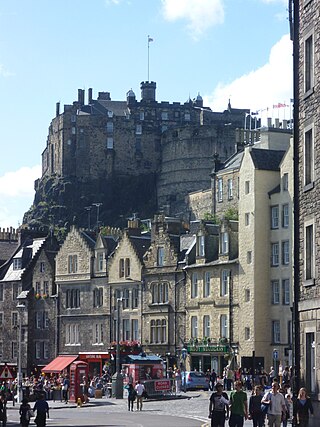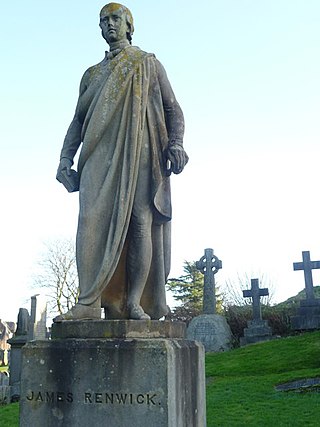Dean Village is a former village immediately northwest of the city centre of Edinburgh, Scotland. It is bounded by Belford Road to the south and west, Belgrave Crescent Gardens to the north and below the Dean Bridge to the east. It was formerly known as the "Water of Leith Village" and was a successful grain milling area for more than 800 years. At one time there were no fewer than eleven working mills there, driven by water from the Water of Leith.

The Porteous Riots surrounded the activities of Captain John Porteous, Captain of the City Guard of Edinburgh, Scotland, who was lynched by a mob for his part in the killing of innocent civilians while ordering the men under his command to quell a disturbance during a public hanging in the Grassmarket, Edinburgh in April 1736. Although the rioters were generally supportive of the convicted smugglers, Porteous seems to have been a somewhat overbearing official, despised by the mob and the underclasses of Edinburgh society.
Captain John Porteous was a Scottish military officer who served in the Edinburgh City Guard and played a major role in the Porteous Riots, which resulted in his death.

The Maiden is an early form of guillotine, or gibbet, that was used between the 16th and 18th centuries as a means of execution in Edinburgh, Scotland. The device was introduced in 1564 during the reign of Mary Queen of Scots, and was last used in 1716. It long predates the use of the guillotine during the French Revolution.

The Grassmarket is a historic market place, street and event space in the Old Town of Edinburgh, Scotland. In relation to the rest of the city it lies in a hollow, well below surrounding ground levels.

James Gillespie Graham was a Scottish architect, prominent in the early 19th century.

This article is a timeline of the history of Edinburgh, Scotland, up to the present day. It traces its rise from an early hill fort and later royal residence to the bustling city and capital of Scotland that it is today.

James Renwick was a Scottish minister who was the last of the Covenanter martyrs to be executed before the Glorious Revolution.

Greyfriars Kirk is a parish church of the Church of Scotland, located in the Old Town of Edinburgh, Scotland. It is surrounded by Greyfriars Kirkyard.

Leith Walk is one of the longest streets in Edinburgh, Scotland, and is the main road connecting the east end of the city centre to Leith.

Younger's Brewery was a brewery in Edinburgh. Established in 1749, it became one of the city’s main commercial enterprises, supplying domestic and foreign markets.

There have been several town walls around Edinburgh, Scotland, since the 12th century. Some form of wall probably existed from the foundation of the royal burgh in around 1125, though the first building is recorded in the mid-15th century, when the King's Wall was constructed. In the 16th century the more extensive Flodden Wall was erected, following the Scots' defeat at the Battle of Flodden in 1513. This was extended by the Telfer Wall in the early 17th century. The walls had a number of gates, known as ports, the most important being the Netherbow Port, which stood halfway down what is now the Royal Mile. This gave access from the Canongate which was, at that time, a separate burgh.

John RhindARSA (1828–1892) was a Scottish sculptor, based in Edinburgh. He was born in Banff the son of a master mason. He was trained under Alexander Handyside Ritchie (1804–1870). He served this apprenticeship in a yard at 4 East Broughton Place.

The Old Tolbooth was an important municipal building in the city of Edinburgh, Scotland for more than 400 years. The medieval structure, which was located at the northwest corner of St Giles' Cathedral and was attached to the west end of the Luckenbooths on the High Street in the Old Town, was first established in the 14th century by royal charter. Over the years it served a variety of purposes such as housing the Burgh Council, early meetings of the Parliament of Scotland and the Court of Session. The Tolbooth was also the burgh's main jail where, in addition to incarceration, physical punishment and torture were routinely conducted. From 1785 public executions were carried out. In 1817 the buildings, which had been rebuilt and renovated several times, were demolished.
Jane Weir or Jean Weir, was a Scottish woman executed for witchcraft. She was the sister of Major Thomas Weir who was charged with incest and witchcraft in 1670 and was subsequently executed.

James Mitchell or James Mitchel,, was a religious covenanter who tried to assassinate Archbishop James Sharp.
Archibald Stewart of Mitcham MP (1697–1780) was an 18th-century Scottish merchant and politician who served as Lord Provost of Edinburgh during the critical Jacobite Rebellion of 1745. He was imprisoned in the Tower of London for over a year owing to his alleged negligence.
Archibald Wauchope of Niddrie Scottish landowner and rebel.
Nicol Muschat (1695–1721) was a Scottish physician, remembered for his murder of his teenage wife, Margaret Hall (1704-1720).















